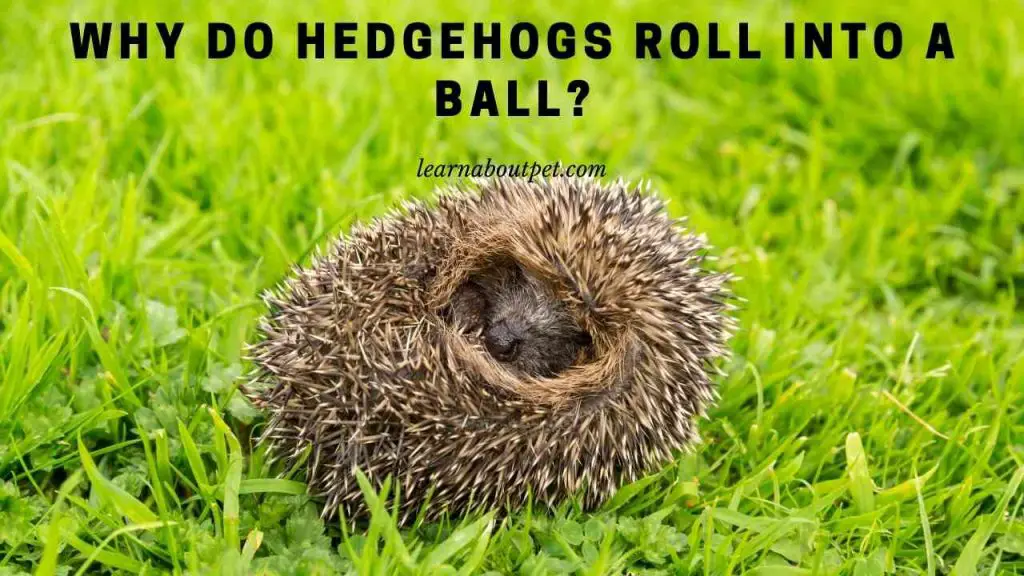One of the most intriguing things about hedgehogs is their tendency to roll into balls at times. People often express interest in knowing why and how hedgehogs roll into a ball. This article has the answers.
Why do hedgehogs roll into a ball? Hedgehogs roll into a ball because of intense fear. Stress or agitation may also make pet hedgehogs roll into balls. And a hedgehog may tend to roll into a ball when it is about to go into hibernation. Rolling into a ball for them is a self-preservation measure.
When a hedgehog rolls into a ball, its quills (spikes) stick out. Therefore any predator that tries to attack it ends up being hurt by the quills. And when a hedgehog rolls up into a ball, its limbs and belly – which a predator could latch onto – are safely hidden.

How Does A Hedgehog Roll Up?
In answering the why do hedgehogs roll into a ball question, it is important for us to first understand how they do it.
Knowing how the hedgehogs roll up will give us key insights on why they do it.
So, indeed, how does a hedgehog roll up? For instance, do hedgehogs roll like sonic? Or do hedgehogs roll around like porcupines?
As it turns out, hedgehogs roll around using muscles that are on their backs. When these muscles contract, the force goes in opposite directions, making it possible for the hedgehog to roll into a relatively tight ball.
Therefore in a way, a hedgehog rolls up in a manner similar to how a porcupine does.
Or if you have ever encountered a pangolin rolled into a ball, that is more or less similar to how hedgehogs roll up.
The sight of a hedgehog rolled into a ball is a fascinating one. It can be especially fascinating if it is the first time you are encountering a hedgehog curled up not moving.
And if the hedgehog in question is your pet, it can be cause for a great deal of concern. But it is worth understanding that rolling up into balls is something hedgehogs do. So it is not out of ordinary.
When a hedgehog rolls into a ball, its quills (spines) become erect and hence sharp. Any predator that tries to pick it up ends up being hurt by the quills.
The hedgehog is also largely unrecognizable to potential predators when in this posture.
All in all, what the hedgehog does is contract some muscles on its back, in order to roll up into a tight ball.
With this background information, we can now venture deeper to find out, why do hedgehogs roll into a ball?
Why Do Hedgehogs Roll Into A Ball?
So far, we have established that hedgehogs roll into a ball by contracting some muscles on their backs.
Yet for someone encountering their hedgie in that posture, the real burning question would be, why is my hedgehog in a ball? Why does a hedgehog roll into a tight ball? Or more generally, why do hedgehogs curl up in a ball?
The simple answer is that hedgehogs roll into a ball when something scares them greatly. Typically, what will scare a hedgehog into a ball is something it perceives as a potential predator (or otherwise a real threat to its life).
So that is the simple answer to the why do hedgehogs roll up into a ball question.
Rolling into a ball is usually a last resort measure. In optimal conditions, the hedgehog will flee (usually by running) from what it perceives as a threat.
But where fleeing doesn’t seem like a viable strategy, it will roll into a ball: as a last resort measure.
Rolling into a ball serves three purposes.
Firstly, when a hedgehog rolls into a ball, its quills stick out. Therefore the predator (or whatever is pursuing it) won’t be able to get to it, without get hurt by the sharp quills.
Secondly, when the hedgehog rolls into a ball, it becomes hard to recognize and largely unattractive to whatever was pursuing it.
And thirdly, when a hedgehog rolls into a ball, its limbs and soft underbelly gets hidden and hence protected.
Of course, there is another scenario where a hedgehog may roll into a ball when it is about to hibernate. In hibernation mode, a hedgehog is very vulnerable: hence the need for it to roll up before going into that mode.
Can All Hedgehogs Roll Into A Ball?
More often than not, alongside the why do hedgehogs roll into a ball question comes this one: on whether all hedgehogs can roll into a ball.
The answer is that all hedgehogs are born with the ability to roll into a ball. It is something that is hardwired into their DNA.
But because of things like obesity and other medical conditions, some hedgehogs may lose the ability to roll into a ball.
And some pet hedgehogs may get so comfortable in their homes that need never arises for them to roll into a ball. Indeed, there are many hedgehog owners who say that they have never seen their hedgies roll into balls.
But all hedgehogs are at least born with the ability to roll into a ball.

How Long Do Hedgehogs Stay In A Ball?
The people who pose the why do hedgehogs curl in a ball question also often express interest in knowing how long hedgehogs stay that way.
Therefore while answering the why do hedgehogs roll into a ball question, it is important to deal with this as well.
Now the true position is that a hedgehog can stay in a ball for a matter of minutes. This is the case if, for instance, it has gotten in a ball because of something it perceives as a threat.
In this case, the hedgehog may uncurl within, say, 5 minutes, 10 minutes or 20 minutes. But it could also stay in this posture for longer, if it feels that whatever was scaring it is still around.
On the other hand, when it comes to situations where hedgehogs roll into balls for hibernation, that can be a matter of months.
In some parts, a wild hedgehog may hibernate from November to March. All that while, it will be rolled up into a ball.
It is also worth mentioning that there are hedgehogs that roll up into balls before going to sleep. When do hedgehogs usually sleep? That is during the day. And how long do hedgehogs usually sleep? That is 8 to 12 hours. All this while, the hedgehog may be curling as a ball.
Therefore how long hedgehogs stay in a ball can be a matter of minutes (when something is scaring it). It may also be a matter of hours (when sleeping). And it can be a matter of months (while hibernating).
Why Is My Hedgehog Staying In A Ball?
Quite often, the person posing the why do hedgehogs roll into a ball question will be someone whose pet hedgehog is lately rolling into a ball, and staying in that position for long periods of time.
So for such a person, the real interest would be in knowing why their hedgehog is behaving in that manner.
Now while answering the why do hedgehogs roll into a ball question, we saw that it is usually because something is scaring them greatly. So they roll into a ball as a self-preservation measure.
But we also saw that pet hedgehogs may roll into a ball because of stress or agitation.
Therefore if your hedgehog is staying in a ball, it may be because something is continually scaring it. This may be another pet you have. Or it may be some sound coming into your house. It could even be some movements around where you keep the hedgehog.
Then again, it may be because the hedgehog is under stress. For instance, if you completely neglect a hedgehog, it may exhibit such behavioral changes.
That is why, before adopting a hedgehog, you need to know things like what do hedgehogs eat, what do hedgehogs like, what do hedgehogs dislike and so on.
You should also go further and try to understand, how do I know if my hedgehog is happy? And how do I know if my hedgehog is unhappy?
It is in the latter context that you would come to learn that rolling up into a ball may be a sign that something is stressing or agitating the hedgehog. In other words, it may be a sign that the hedgehog is unhappy.
But rolling up could also be a sign that the hedgehog is about to hibernate.
What Should You Do If Your Hedgehog Is Rolled Into A Ball?
After answering the why do hedgehogs roll into a ball question, it is also important for us to comment on what to do with a hedgehog that is rolling up.
Now ideally, what you should do with a hedgehog that is rolled into a ball is to just let it be. Let whatever it is perceiving as a threat pass. Then it should uncurl itself in due course.
But what if it is curling in a place where someone may trample on it? In this case, you may gently pick it up and put it into its cage. Then let it stay there until it feels comfortable enough to uncurl itself.
And what of the cases where the hedgehog is curling up for long periods, meaning that it may be about to hibernate? In this case, you need to raise the temperatures in its cage. And do whatever it takes to ensure that it doesn’t hibernate.
Pet hedgehogs normally don’t have what it takes to go through hibernation successfully. Therefore you need to ensure that your hedgehog doesn’t go into hibernation mode.
Final Verdict – Why Do Hedgehogs Roll Into A Ball
Hedgehogs normally roll into a ball when something scares them greatly. This may be something that they perceive as a potential predator or otherwise a real threat to their lives.
The hedgehogs roll into balls by contracting certain muscles on their backs. When they roll into balls, their quills stick out: serving as deterrents to potential predators.
Further, when they roll into balls, their bellies and limbs are protected. And in that posture, they are not very easily recognizable by (or attractive to) potential predators. Therefore, curling up is a self-preservation measure.

In the domestic setting, hedgehogs may curl up into a ball if something is scaring, agitating or stressing them.
There are also instances where hedgehogs may start curling up for extended periods, sometimes meaning that they are about to hibernate.
Where your hedgehog is curling up for long, indicating that it is about to hibernate, you may need to raise the temperatures in its cage and do whatever it takes to ensure that it doesn’t go into hibernation.
As a pet lover, make sure to learn about pet more and give your pet hedgehog a good and comfortable life!

Welcome to Learn About Pet. My name is Rajkumar Ravichandran and I love all pets, travel, and amazing food. I write about my passion and personal experience caring for multiple pets in this blog! ❤️
Post Disclaimer
DISCLAIMER: THIS BLOG OR WEBSITE, "Learn About Pet", DOES NOT PROVIDE YOU WITH MEDICAL ADVICE AND IS NOT A SUBSTITUTE FOR MEDICAL ADVICE. ALWAYS GET IN TOUCH WITH YOUR PERSONAL VETERINARIAN AND USE INFORMATION HERE AS GENERAL ADVICE.
The information, including but not limited to, text, graphics, images and other material contained on this website are for informational purposes only. No material on this site is intended to be a substitute for professional veterinary advice, food recommendation, diagnosis, or treatment. Always seek the advice of your veterinarian or other qualified health care provider with any questions you may have regarding a medical condition or for pet food related questions.







